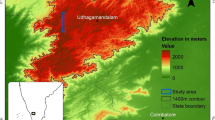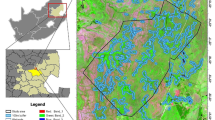Abstract
For monitoring and controlling the extent and intensity of an invasive species, a direct multi-date image classification method was applied in invasive species (salt cedar) change detection in the study area of Lovelock, Nevada. With multidate Compact Airborne Spectrographic Imager (CASI) hyperspectral data sets, two types of hyperspectral CASI input data and two classifiers have been examined and compared for mapping and monitoring the salt cedar change. The two types of input data are all two-date original CASI bands and 12 principal component images (PCs) derived from the two-date CASI images. The two classifiers are an artificial neural network (ANN) and linear discriminant analysis (LDA). The experimental results indicate that (1) the direct multitemporal image classification method applied in land cover change detection is feasible either with original CASI bands or PCs, but a better accuracy was obtained from the CASI PCA transformed data; (2) with the same inputs of 12 PCs, the ANN outperforms the LDA due to the ANN’s non-linear property and ability of handling data without a prerequisite of a certain distribution of the analysis data.
Similar content being viewed by others
References
Abuelgasim, A. A., Ross, W. D., Gopal, S., & Woodcock, C. E. (1999). Change detection using adaptive fuzzy neural networks: Environmental damage assessment after the Gulf War. Remote Sensing of Environment, 70, 208–223.
Aplin, P. (2006). On scales and dynamics in observing the environment. International Journal of Remote Sensing, 27(11), 2123–2140.
Bruzzone, L., Prieto, D. F., & Serpico, S. B. (1999). A neural-statistical approach to multitemporal and multisource remote-sensing image classification. IEEE Transactions on Geoscience and remote Sensing, 31, 511–515.
Civco, D. L., Hurd, J. D., & Wilson, E. H. (2002). A comparison of land use and land cover change detection methods. In Proceedings of ASPRS Annual Convention (p. 12). Washington, DC: ASPRS, 22–26 April 2002.
Congalton, R. G., & Mead, R. A. (1983). A quantitative method to test for consistency and correctness in photointerpretation, Photogrammetric Engineering and Remote Sensing, 49(1), 69–74.
Congalton, R. G., Oderwald, R. G., & Mead, R. A. (1983). Assessing Landsat classification accuracy using discrete multivariate statistical techniques. Photogrammetric Engineering and Remote Sensing, 49(12), 1671–1678.
Coppin, P., Jonckheere, I., Nackaerts, K., Muys, B., & Lambin, E. (2004). Digital change detection methods in ecosystem monitoring: A review. International Journal of Remote Sensing, 25(9), 1565–1596.
Dai, X. L., & Khorranm, S. (1999). Remotely sensed change detection based on artificial neural networks. Photogrammetric Engineering and Remote Sensing, 65, 1187–1194.
Foody, G. M. (2002). Status of land cover classification accuracy assessment. Remote Sensing of Environment, 80, 185–201.
Foody, G. M., McCulloch, M. B., & Yates, W. B. (1995). Classification of remotely sensed data by an artificial neural network: Issue related to training data characteristics. Photogrammetric Engineering and Remote Sensing, 61, 391–401.
Fung, T., & LeDrew, E. (1988). The determination of optimal threshold levels for change detection using various accuracy indices. Photogrammetric Engineering and Remote Sensing, 54(10), 1449–1454.
Gong, P., Pu, R. & Yu, B. (1997). Conifer species recognition: An exploratory analysis of in situ hyperspectral data. Remote Sensing of Environment, 62, 189–200.
Gong, P., & Xu, B. (2004). Remote sensing of forests over time-change types, methods, and opportunities (pp. 301–333). The Netherlands: Kluwer.
Gopal, S., & Woodcock, C. E. (1996). Remote sensing of forest change using artificial neural networks. IEEE Transactions on Geoscience and Remote Sensing, 34, 398–404.
Hayes, D. J., & Sader, S. A. (2001). Comparison of change-detection techniques for monitoring tropical forest clearing and vegetation regrowth in a time series. Photogrammetric Engineering and Remote Sensing, 67(9), 1067–1075.
Jackson, R. B., Banner, J. L., Jobbagy, E. G., Pockman, W. T., & Wall, D. H. (2002). Ecosystem carbon loss with woody plant invasive pf grasslands. Nature, 418, 623–626.
Johnson, W., Davison, J., Young, J., & Kadrmas, T. (2005). Managing Saltcedar, http://www.unce.unr.edu/publications/FS02/FS0293.pdf, access on May 15, 2005. University of Nevada, Reno
Khan, S. D. (2005). Urban development and flooding in Houston Texas, inferences from remote sensing data using neural network technique. Environmental Geology, 47, 1120–1127.
Lass, L. W., Thill, D. C., Shafii, B., & Prather, T. S. (2002). Detecting spotted knapweed (Centaurea maculosa) with hyperspectral remote sensing technology. Weed Technology, 16(2), 426–432.
Liu, X., & Lathrop, R. G. Jr. (2002). Urban change detection based on an artificial neural network. International Journal of Remote Sensing, 23, 2513–2518.
Lu, D., Mausel, P., Brondizio, E., & Moran, E. (2004). Change detection techniques. International Journal of Remote Sensing, 25(12), 2365–2407.
Mack, R. N., Simberloff, D., Lonsdale, W. M., Evans, H., Clout, M., & Bazzaz, F. (2000). Biotic invasions: causes, epidemiology, global consequences and control. Ecological Application, 10, 689–710.
Miao, X., Gong, P., Swope, S., Pu, R., Carruthers, R., Anderson, G. L. et al. (2006). Estimation of yellow starthistle abundance through CASI-2 hyperspectral imagery using linear spectral mixture models. Remote Sensing of Environment, 101(3), 329–341.
Nemmour, H., & Chibani, Y. (2006). Fuzzy neural network architecture for change detection in remotely sensed imagery. International Journal of Remote Sensing, 27(4), 705–717.
Pao, Y. (1989). Adaptive pattern recognition and neural networks. New York: Addison and Wesley.
Pu, R., Gong, P., Tian, Y., Miao, X., Carruthers, R. I., & Anderson, G. L. (2007a). Using classification and NDVI differencing methods for monitoring sparse vegetation coverage: A case study of saltcedar in Nevada, USA. International Journal of Remote Sensing (in press)
Pu, R., Kelly, M., Anderson, G. L., & Gong, P. (2007b). Using CASI hyperspectral imagery to detect mortality and vegetation stress associated with a new hardwood forest disease. Photogrammetric Engineering and Remote Sensing (in press).
Rumelhart, D. E., Hinton, G. E., & Williams, R. J. (1986). Learning internal representations by error propagation. In D. E Rumelhart & J. L. McCelland (Eds.) Parallel distributed processing-explorations in the microstructure of cognition, vol. 1 (pp. 318–362). Cambridge, MA: MIT Press.
SAS Institute Inc. (1991). SAS/STA User’s Guide, Release 6.03 Edition (p. 1028). Gary, NC: SAS Institute Inc., USA.
Seto, K. C., & Liu, W. (2003). Comparing ARTMAP neural network with the maximum-likelihood classifier for detecting urban change. Photogrammetric Engineering and Remote Sensing, 69(9), 981–990.
Simberloff, D. (2001). Biological invasions: How are they affecting us and what can we do about them? Western North American Naturalist, 61, 308–315.
Sunar Erbek, F., Özkan, C., & Taberner, M. (2004). Comparison of maximum likelihood classification method with supervised artificial neural network algorithms for land use activities. International Journal of Remote Sensing, 25(9), 1733–1748.
Underwood, E., Ustin, S., & DiPietro, D. (2003). Mapping nonnative plants using hyperspectral imagery. Remote Sensing of Environment, 86(2), 150–161.
USDA ARS (2005). Saltcedar, Tamarix spp.: An emerging success. Retrieved May 15, 2005 from http://www.invasivespecies.gov/docs/ars/issssaltcedar.pdf.
Ustin, S. L., Scheer, G., DiPietro, D., Underwood, E., & Olmstead, K. (2001). Hyperspectral remote sensing for invasive species detection and mapping. Abstracts of Papers of the American Chemical Society, 221, U50.
van Aardt, J. A. N., & Wynne, R. H. (2001). Spectral separability among six southern tree species. Photogrammetric Engineering and Remote Sensing, 67, 1367–1375.
Author information
Authors and Affiliations
Corresponding author
Rights and permissions
About this article
Cite this article
Pu, R., Gong, P., Tian, Y. et al. Invasive species change detection using artificial neural networks and CASI hyperspectral imagery. Environ Monit Assess 140, 15–32 (2008). https://doi.org/10.1007/s10661-007-9843-7
Received:
Accepted:
Published:
Issue Date:
DOI: https://doi.org/10.1007/s10661-007-9843-7




